1.44: Zeus
- Page ID
- 15384
\( \newcommand{\vecs}[1]{\overset { \scriptstyle \rightharpoonup} {\mathbf{#1}} } \)
\( \newcommand{\vecd}[1]{\overset{-\!-\!\rightharpoonup}{\vphantom{a}\smash {#1}}} \)
\( \newcommand{\dsum}{\displaystyle\sum\limits} \)
\( \newcommand{\dint}{\displaystyle\int\limits} \)
\( \newcommand{\dlim}{\displaystyle\lim\limits} \)
\( \newcommand{\id}{\mathrm{id}}\) \( \newcommand{\Span}{\mathrm{span}}\)
( \newcommand{\kernel}{\mathrm{null}\,}\) \( \newcommand{\range}{\mathrm{range}\,}\)
\( \newcommand{\RealPart}{\mathrm{Re}}\) \( \newcommand{\ImaginaryPart}{\mathrm{Im}}\)
\( \newcommand{\Argument}{\mathrm{Arg}}\) \( \newcommand{\norm}[1]{\| #1 \|}\)
\( \newcommand{\inner}[2]{\langle #1, #2 \rangle}\)
\( \newcommand{\Span}{\mathrm{span}}\)
\( \newcommand{\id}{\mathrm{id}}\)
\( \newcommand{\Span}{\mathrm{span}}\)
\( \newcommand{\kernel}{\mathrm{null}\,}\)
\( \newcommand{\range}{\mathrm{range}\,}\)
\( \newcommand{\RealPart}{\mathrm{Re}}\)
\( \newcommand{\ImaginaryPart}{\mathrm{Im}}\)
\( \newcommand{\Argument}{\mathrm{Arg}}\)
\( \newcommand{\norm}[1]{\| #1 \|}\)
\( \newcommand{\inner}[2]{\langle #1, #2 \rangle}\)
\( \newcommand{\Span}{\mathrm{span}}\) \( \newcommand{\AA}{\unicode[.8,0]{x212B}}\)
\( \newcommand{\vectorA}[1]{\vec{#1}} % arrow\)
\( \newcommand{\vectorAt}[1]{\vec{\text{#1}}} % arrow\)
\( \newcommand{\vectorB}[1]{\overset { \scriptstyle \rightharpoonup} {\mathbf{#1}} } \)
\( \newcommand{\vectorC}[1]{\textbf{#1}} \)
\( \newcommand{\vectorD}[1]{\overrightarrow{#1}} \)
\( \newcommand{\vectorDt}[1]{\overrightarrow{\text{#1}}} \)
\( \newcommand{\vectE}[1]{\overset{-\!-\!\rightharpoonup}{\vphantom{a}\smash{\mathbf {#1}}}} \)
\( \newcommand{\vecs}[1]{\overset { \scriptstyle \rightharpoonup} {\mathbf{#1}} } \)
\( \newcommand{\vecd}[1]{\overset{-\!-\!\rightharpoonup}{\vphantom{a}\smash {#1}}} \)
\(\newcommand{\avec}{\mathbf a}\) \(\newcommand{\bvec}{\mathbf b}\) \(\newcommand{\cvec}{\mathbf c}\) \(\newcommand{\dvec}{\mathbf d}\) \(\newcommand{\dtil}{\widetilde{\mathbf d}}\) \(\newcommand{\evec}{\mathbf e}\) \(\newcommand{\fvec}{\mathbf f}\) \(\newcommand{\nvec}{\mathbf n}\) \(\newcommand{\pvec}{\mathbf p}\) \(\newcommand{\qvec}{\mathbf q}\) \(\newcommand{\svec}{\mathbf s}\) \(\newcommand{\tvec}{\mathbf t}\) \(\newcommand{\uvec}{\mathbf u}\) \(\newcommand{\vvec}{\mathbf v}\) \(\newcommand{\wvec}{\mathbf w}\) \(\newcommand{\xvec}{\mathbf x}\) \(\newcommand{\yvec}{\mathbf y}\) \(\newcommand{\zvec}{\mathbf z}\) \(\newcommand{\rvec}{\mathbf r}\) \(\newcommand{\mvec}{\mathbf m}\) \(\newcommand{\zerovec}{\mathbf 0}\) \(\newcommand{\onevec}{\mathbf 1}\) \(\newcommand{\real}{\mathbb R}\) \(\newcommand{\twovec}[2]{\left[\begin{array}{r}#1 \\ #2 \end{array}\right]}\) \(\newcommand{\ctwovec}[2]{\left[\begin{array}{c}#1 \\ #2 \end{array}\right]}\) \(\newcommand{\threevec}[3]{\left[\begin{array}{r}#1 \\ #2 \\ #3 \end{array}\right]}\) \(\newcommand{\cthreevec}[3]{\left[\begin{array}{c}#1 \\ #2 \\ #3 \end{array}\right]}\) \(\newcommand{\fourvec}[4]{\left[\begin{array}{r}#1 \\ #2 \\ #3 \\ #4 \end{array}\right]}\) \(\newcommand{\cfourvec}[4]{\left[\begin{array}{c}#1 \\ #2 \\ #3 \\ #4 \end{array}\right]}\) \(\newcommand{\fivevec}[5]{\left[\begin{array}{r}#1 \\ #2 \\ #3 \\ #4 \\ #5 \\ \end{array}\right]}\) \(\newcommand{\cfivevec}[5]{\left[\begin{array}{c}#1 \\ #2 \\ #3 \\ #4 \\ #5 \\ \end{array}\right]}\) \(\newcommand{\mattwo}[4]{\left[\begin{array}{rr}#1 \amp #2 \\ #3 \amp #4 \\ \end{array}\right]}\) \(\newcommand{\laspan}[1]{\text{Span}\{#1\}}\) \(\newcommand{\bcal}{\cal B}\) \(\newcommand{\ccal}{\cal C}\) \(\newcommand{\scal}{\cal S}\) \(\newcommand{\wcal}{\cal W}\) \(\newcommand{\ecal}{\cal E}\) \(\newcommand{\coords}[2]{\left\{#1\right\}_{#2}}\) \(\newcommand{\gray}[1]{\color{gray}{#1}}\) \(\newcommand{\lgray}[1]{\color{lightgray}{#1}}\) \(\newcommand{\rank}{\operatorname{rank}}\) \(\newcommand{\row}{\text{Row}}\) \(\newcommand{\col}{\text{Col}}\) \(\renewcommand{\row}{\text{Row}}\) \(\newcommand{\nul}{\text{Nul}}\) \(\newcommand{\var}{\text{Var}}\) \(\newcommand{\corr}{\text{corr}}\) \(\newcommand{\len}[1]{\left|#1\right|}\) \(\newcommand{\bbar}{\overline{\bvec}}\) \(\newcommand{\bhat}{\widehat{\bvec}}\) \(\newcommand{\bperp}{\bvec^\perp}\) \(\newcommand{\xhat}{\widehat{\xvec}}\) \(\newcommand{\vhat}{\widehat{\vvec}}\) \(\newcommand{\uhat}{\widehat{\uvec}}\) \(\newcommand{\what}{\widehat{\wvec}}\) \(\newcommand{\Sighat}{\widehat{\Sigma}}\) \(\newcommand{\lt}{<}\) \(\newcommand{\gt}{>}\) \(\newcommand{\amp}{&}\) \(\definecolor{fillinmathshade}{gray}{0.9}\)Roman name: Jupiter/Jove
Epithets: Kronion (Son of Cronus), Father of Gods and Men
Symbols: throne, scepter, thunderbolt, aegis, eagle, bull
Functions: God of the sky and weather; Ruler of the gods
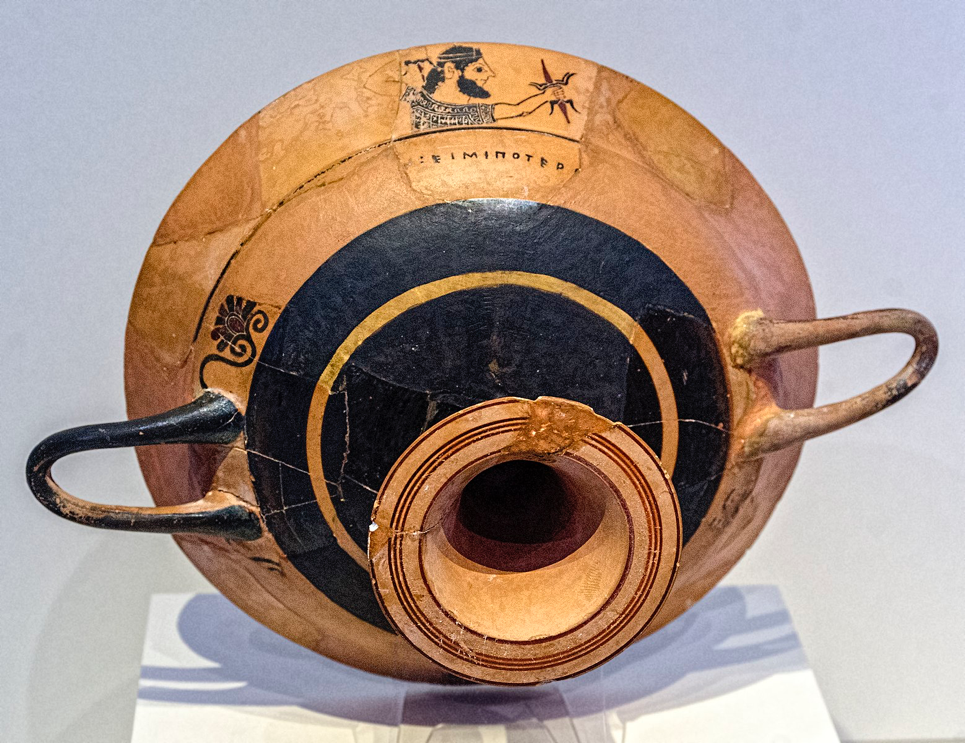
Zeus with his thunderbolt on a kylix in the National Archaeological Museum of Spain in Madrid
The Birth of Zeus
Zeus was the youngest son of Cronus and Rhea. He rescued his siblings from their father, led a revolt against Cronus, and took his position as ruler of the cosmos [see Origins]. Like his grandfather and father before him, Zeus’ rule did not go unchallenged, but he succeeded where they failed and managed to thwart his would be usurpers. After Zeus won the Battle of the Gods and the Titans, Gaia sent the monster Typhoeus against him [see Origins]. Later a race of giants revolted against Zeus, but Zeus defeated them with the help of his mortal son, Heracles.

Zeus fighting Typhoeus on a hydria in the Staatliche Antikensammlungen in Munich
Zeus’ Marriage to Metis
As ruler of the universe, Zeus needed a wife, and he chose Metis, who had helped him rescue his siblings [see Origins]. Metis was the daughter of the Titans Oceanus and Tethys. Her name means “intelligence” or “cunning,” and she is the personification of those qualities. When Metis was pregnant with Athena, Zeus learned that Metis was fated to give birth to a son who would one day overthrow his father. This would have perpetuated the cycle of rulers of the universe being overthrown by their sons, and Zeus wanted to end the cycle once and for all. Since swallowing his children did not work out well for Cronus, Zeus’ father, Zeus decided to swallow his wife instead. So, Zeus swallowed Metis while she was pregnant, leading to Athena’s very unusual birth [see Athena]. Metis lived on within Zeus, providing him advice, helping him to become known for his wisdom and thoughtful arbitration (for an example, see Iliad 24.64-76).
Zeus’ Other Marriages and Liaisons: Themis, Demeter, Leto and Hera
After this marriage ended, Zeus had relationships with several goddesses: Themis (Natural Order), who bore the Horae (the Seasons) and the Moerae (the Fates); Eurynome, who gave birth to the Graces; Demeter, who bore Persephone; Mnemosyne (Memory), who conceived the Muses; Dione, who delivered Aphrodite [see Aphrodite]; and Leto, who begat Apollo and Artemis. (The gods, by the way, never have a sexual encounter in vain; children are always produced.) At some point Zeus married his sister, Hera, and together they had three children: Ares, Eileithyia, and Hebe.
Zeus’ Relationships with Mortal Women
Zeus pursued mortal women even more frequently than he pursued goddesses. He sired the god Dionysus with the mortal woman Semele [see Dionysus]. He came to Alcmene in the form of her husband, Amphitryon [see Heracles], fathering Heracles. He turned Io into a cow to avoid Hera’s wrath [see Hermes or Hera]. Io later traveled to Egypt and bore Epaphus, who became an Egyptian god. Zeus abducted Europa in the form of a bull and took her to Crete, where she bore him three sons, Minos, Rhadamanthys, and Sarpedon. He came to Danaë as a shower of gold, causing her to become pregnant with Perseus. He came to Leda as a swan and she later laid two eggs with two sets of twins. Two were the children of Zeus, Helen and Polydeuces (Pollux in Latin) who were immortal; the other two, Clytemnestra and Castor, were the children of her husband, Tyndareüs, and were mortal.
Hera was notoriously jealous of her husband’s affairs, though this did not stop him from pursuing relationships with both goddesses and mortals.
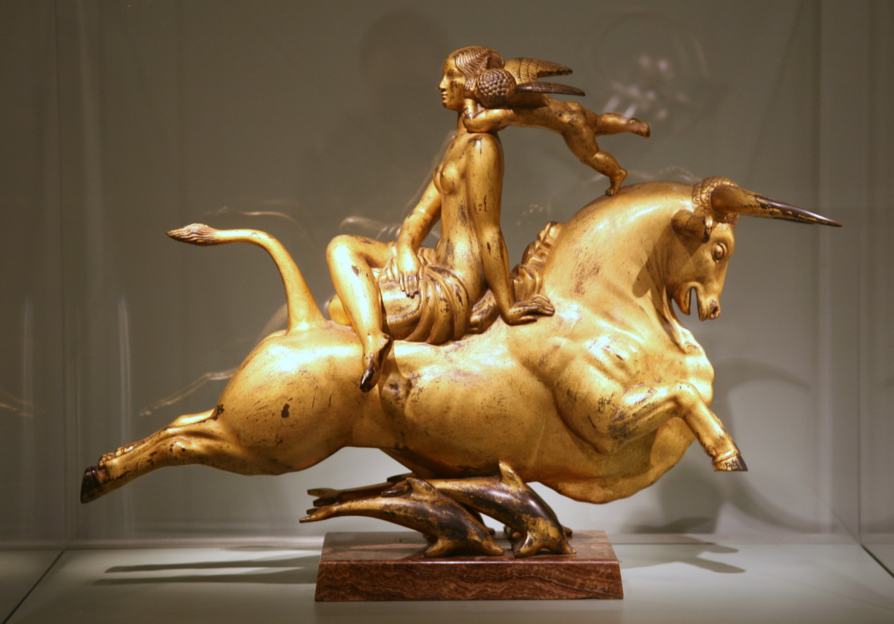
The Flight of Europa by Paul Manship from 1925, copies are in the Indianapolis Museum of Art, the Los Angeles County Museum of Art, the Columbus Museum in Columbus, Georgia, and the Smithsonian American Art Museum in Washington, D.C.
Ganymede
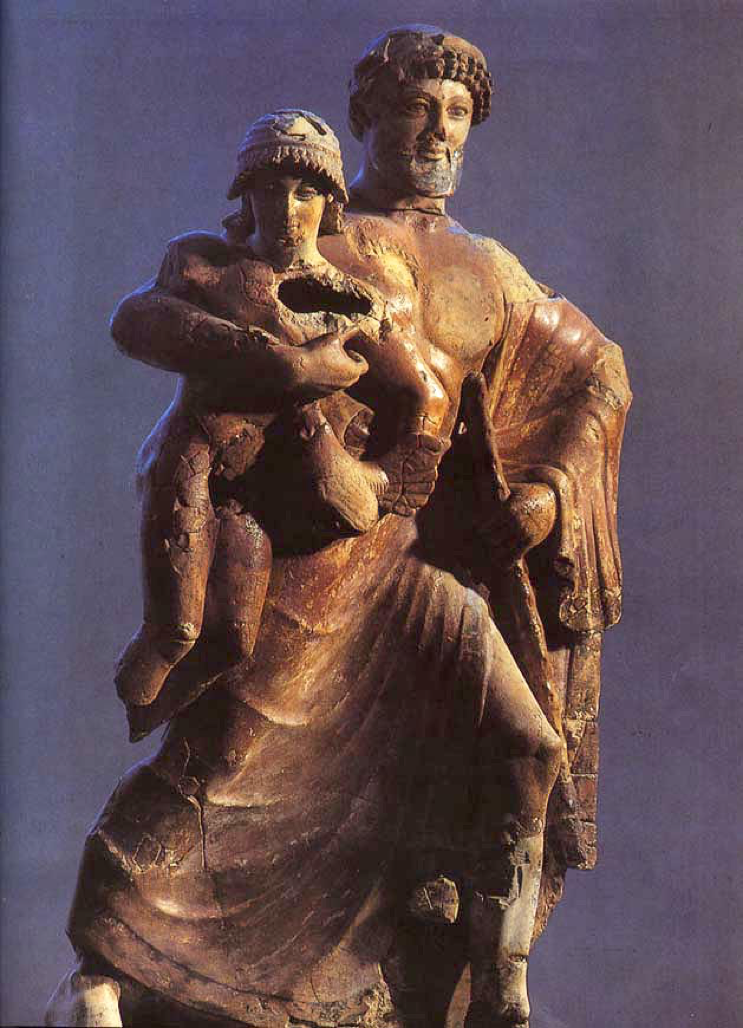
Zeus abducting Ganymede found in the Archaeological Museum in Olympia
Zeus was also attracted to young boys. Ganymede, a young and beautiful Trojan prince, was abducted by Zeus and taken up to Olympus to be his personal cupbearer (and probably his lover as well). In the Aeneid, Virgil cites Ganymede’s presence on Olympus as one of the reasons why Juno was so angry at the Trojans and why she constantly harassed Aeneas, despite Jupiter’s commands to cease.
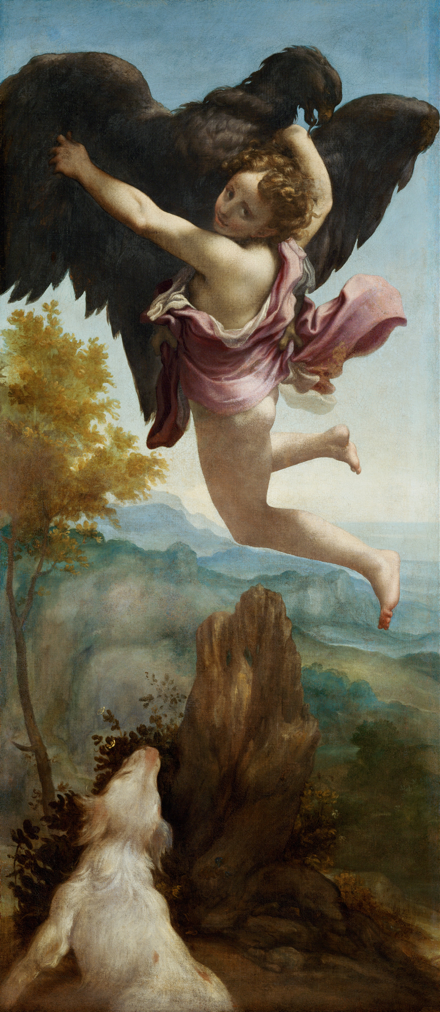
The Abduction of Ganymede by Correggio in the Kunsthistorisches Museum in Vienna
The Justice of Zeus
Because Zeus was the ruler of the gods, the gods often took their quarrels to Zeus for arbitration. He also meted out punishments to immortals and mortals alike who angered him. When the Titan Prometheus stole fire to give to mortals, Zeus had him chained to a mountain where every day, an eagle would come and eat out the Titan’s liver; but it grew back again every night and the process would begin again the next day [see Prometheus]. The Lydian King, Tantalus, was a son of Zeus who was favored by the gods, but he wanted to test their knowledge and power. He invited the gods to a dinner party and served them a dish made from his own son, Pelops. The gods knew immediately that the meat they were served was human flesh (except for Demeter who was grieving for her daughter, Persephone, and had eaten a bit of Pelops’ shoulder). The gods grew very angry at Tantalus’ sacrilege. They put Pelops together again (giving him an ivory shoulder to replace the one that had been eaten) and Tantalus was punished in the Underworld by having to stand up to his chin in a lake that would recede any time he moved to take a drink and overhead was a tree with delicious, ripe fruit that would move away from him when he tried to reach up and grab one. (This myth is the origin of the word tantalize.)
Zeus’ Possible Origins
Zeus was the sky god of the Mycenaean (Greek-speaking) peoples who migrated to the Greek peninsula sometime around 2000 BC. As the sky god, he was in charge of the weather, and he was known to cause thunderstorms by hurling his thunder-bolt (= lightning bolt).
Zeus may have been conflated with a pre-Greek Minoan fertility god on the island of Crete. This was the child and/or young male consort of a female fertility goddess. This would help to explain the story of Zeus being brought to Crete as a baby and living on Crete for a year in a cave [see Origins]. The Minoans seem to have sometimes worshipped this god in the form of a bull, and that might explain why Zeus sometimes takes that form. This is probably how the details of the story of the rape of Europa came about, solidifying Zeus’ connection to this god and to the island of Crete as well as establishing the mythological ruling family of the island (the Minoans were said to have descended from King Minos, one of the sons of Zeus and Europa). Zeus was easily adapted to the ill-defined Roman god, Jupiter (whose name means “sky father”), as the Roman god Jupiter did not have a strong personality of his own.
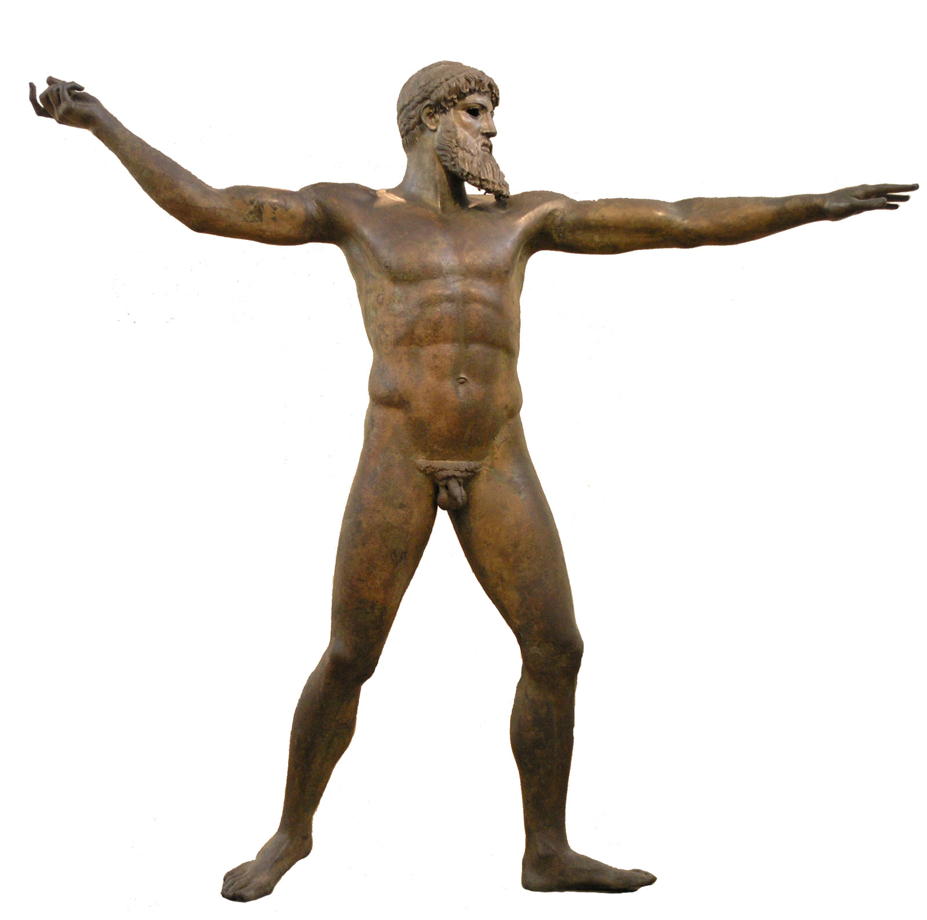
Zeus or Poseidon (we cannot tell which without the missing object in the figure’s right hand) in the National Archaeological Museum in Athens
Zeus in the Trojan War
Although Troy was one of Zeus’ favorite cities (as he explains to Hera at Iliad 4.44-49), he seems to have been neutral in the Trojan War. In Book 16 of the Iliad, for example, Zeus first favors Patroclus as he kills many Trojans and their allies (including Sarpedon, another one of his sons by Europa) but he also makes sure that Patroclus is, in turn, killed by Hector. Despite his love for Troy, however, Zeus knew that as long as the Trojans made certain decisions, Troy would eventually fall (this is clear, for example, at Iliad 4.68-72). (To the Greeks, fate was partially determined by choice, as can be seen in Achilles’ choice in the Iliad.) At one point (Iliad 8.1-18), Zeus even ordered a cessation of divine involvement in the conflict (but as we will see when we read the Iliad, this does not stop them).

